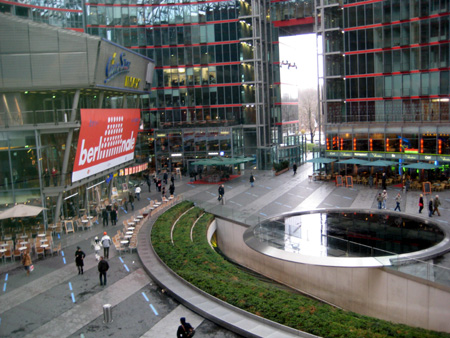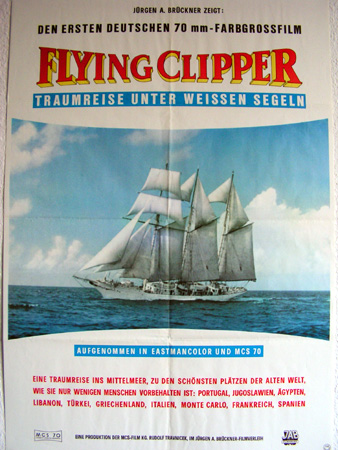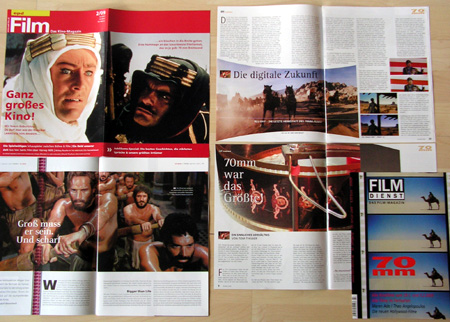70mm Alive and kicking in Berlin!
|
Read more
at in70mm.com The 70mm Newsletter |
| Written by: Johan C. M. Wolthuis, International 70mm Publishers, Holland. Images by Jan-Hein Bal, Holland | Date: 30.04.2009 |
 This year's 59th Berlinale Filmfestival which took place from 5 to 15 February [2009], was partly devoted to the phenomenon of the 70mm film. This filmfestival in Berlin is one of the most important festivals of the world in relation to its large film distribution market. This year's 59th Berlinale Filmfestival which took place from 5 to 15 February [2009], was partly devoted to the phenomenon of the 70mm film. This filmfestival in Berlin is one of the most important festivals of the world in relation to its large film distribution market.Although it was a small part of the festival, during ten days a total of 22 films have been screened in a so-called 70mm Retrospective. No faded prints or blow-ups, but a lot of new prints of original 70mm films. For the first time there were not only the well known epics from the USA to be seen, but also some famous Russian and East German master pieces from the sixties. While the new prints from the USA had their DTS digital sound, the vintage prints from the Soviet Union and the former East German Republic had the old magnetic soundtracks. Thanks to the superb quality of ORWO color and Sovcolor these prints were not at all or minimally faded and in a surprisingly good condition. It was one of the very few times that Russian prints were loaned outside the country. It seemed a remarkable coincidence that the official part of this Berlinale, with new films, started on the opening day (out of competition) with the latest film of German director Tom Tykwer: “The International”. Remarkable, because in one of his many interviews Mr Tykwer (born in 1965) stated that he had used an ARRI 65mm camera for some scenes of his film, because he liked 70mm films since he was a boy. Only because of financial limitations he could use the 65mm cameras for only 10 percent of his film. But it is clear to see that the beautiful panorama views of Istanbul in his film, were taken with the Arri 765 camera. He said that he had taken some close ups from Clive Owen in 65mm, but on the other hand he had also used a VistaVison double frame camera to photograph the shooting scenes in the New York Guggenheim museum. The rotunda of the Guggenheim museum was copied in the Babelsberg studios near Berlin. Mr Tykwer especially praised the cooperation with the German Arri company. Maybe this director is the man for a new impulse of the 70mm film? |
More
in 70mm reading: "Digital & 65mm" - New book from International 70mm Publishers Berlinale 2009 - 70mm Retrospective Berlinale 70mm Retrospective Film Presentation for the 21st Century Johan Wolthuis Says Goodbye Internet link: |
|
The 70mm Retrospective was presented at the old (GDR) Kino International at the Karl Marx Allee and at the new Cinestar 8 at Potsdamer Platz. On the first day, Thursday the 5th, the 70mm Retrospective opened with a rather new print from 2002 of the “Sound of Music” (1965) in the large beautiful red dressed auditorium of the Cinestar 8 cinema. It opened in January 2000, has 519 seats, two Kinoton FP75E and a screen of 17.7 x 7.4 m. The next day a famous Russian epic “Wojna I Mir” ("War and Peace") part 1 & 2 from Russian director Sergej Bondartschuk, (270 minutes) was screened in the Kino International. This cinema has been opened in 1963 as the third 70mm equipped cinema in the German Democratic Republic (second in East Berlin). It is a typical example of a former East German cinema: a large silvergrey colored stadium style auditorium with 550 seats. |
|
 The curved screen had a size of 17.5 x 7.9 metre with a double set of silver and blue curtains. Although it had been build as a 70mm cinema, the 70mm equipment was long gone. But especially for this Retrospective two Philips DP70 projectors were removed from another closed 70mm theatre, the Royal Palast in Berlin, and installed in Kino International where they will stay now for the time being. Specially rented DTS 70mm sound readers were temporarily installed as well. This cinema was build to show the world, or complete the illusion that this Communist country was able to do the same or even more than the western world film industry, thus trying to promote the socialistic ideas of superiority. The former East German leader Erich Honecker had its own seat in this theatre! The curved screen had a size of 17.5 x 7.9 metre with a double set of silver and blue curtains. Although it had been build as a 70mm cinema, the 70mm equipment was long gone. But especially for this Retrospective two Philips DP70 projectors were removed from another closed 70mm theatre, the Royal Palast in Berlin, and installed in Kino International where they will stay now for the time being. Specially rented DTS 70mm sound readers were temporarily installed as well. This cinema was build to show the world, or complete the illusion that this Communist country was able to do the same or even more than the western world film industry, thus trying to promote the socialistic ideas of superiority. The former East German leader Erich Honecker had its own seat in this theatre!Other screenings in the KINO International of famous Russian movies were: “Optimisticheskaya Tragediya“ ("The Optimistic Tragedy", 1963) . “War and Peace” (1962/1967) Parts 3 & 4, running for 3 hours and 5 minutes. “Dnewnyje Swjosdy” 1966 ("Stars of the Day") only 94 minutes, was mentioned to be the favourite film of the festival staff and it was indeed a beautifully composed story with many dreamscenes, based on a Russian book with the same name. It was amazing that this vintage print from the sixties was not faded although the condition was very fragile! All Russian movies were English subtitled. “The Flaming Years” ("Powest Plamennych Let") 1960, was 91 minutes of real war propaganda. It has even been screened in the sixties in the Coliseum Cinerama in London for a short time. And last but not least the Russian/East German coproduction “Goya” from 1969, a beautiful film about the life of the famous Spanish painter, a nice, not faded vintage print in Orwo color. A treat to look at a film, which in my opinion could be distributed again in art houses nowadays! It was quite different from all the other propaganda movies. Between all these Russian mass-productions in Kino International, it was a relief to look at a new print of Ron Fricke's famous non-verbal 70mm epic, from the USA "Baraka", which was photographed during 3 years from 1990 until 1992. We are looking forward with great expectations to his next non verbal 70mm film "Samsara", which is supposed to be ready for screening at the end of this year. |
|
 In the meantime there was another important event during this retrospective: the “premiere” of the restored 2009 70mm print of "Flying Clipper", ("Traumreise Unter Weissen Segeln") the first original 65mm film from West Germany in 1961. It was photographed in the [then, ed] newly developed German MCS 70 - Superpanorama with new cameras and contains fabulous aerial photography along the Mediterranean coast over Monaco, the French Rivièra and along the Greek Coast. This print was especially made for this festival by the Los Angeles based company FotoKem, specialists in restoration of old 70mm films. Unfortunately on the evening of the premiere in Cinestar 8, oh bad luck for this unique event, one of the 70mm projectors refused to work properly. There was an electronic failure and after more than an hour waiting most people went home. Luckily the film had another chance with a Saturday morning screening in Kino International. This same film was distributed in the sixties in the USA and UK by Cinerama Inc. under the name “Mediterranean Holiday”. In the meantime there was another important event during this retrospective: the “premiere” of the restored 2009 70mm print of "Flying Clipper", ("Traumreise Unter Weissen Segeln") the first original 65mm film from West Germany in 1961. It was photographed in the [then, ed] newly developed German MCS 70 - Superpanorama with new cameras and contains fabulous aerial photography along the Mediterranean coast over Monaco, the French Rivièra and along the Greek Coast. This print was especially made for this festival by the Los Angeles based company FotoKem, specialists in restoration of old 70mm films. Unfortunately on the evening of the premiere in Cinestar 8, oh bad luck for this unique event, one of the 70mm projectors refused to work properly. There was an electronic failure and after more than an hour waiting most people went home. Luckily the film had another chance with a Saturday morning screening in Kino International. This same film was distributed in the sixties in the USA and UK by Cinerama Inc. under the name “Mediterranean Holiday”.In the beautiful red auditorium of Cinestar 8 all the new USA prints were shown that were available for this festival: “Sound of Music”, “Lord Jim”, "Patton", “Hello, Dolly!”, “West Side Story” and “STAR!” (both with a new print from 2008), and from France the famous Jacques Tati film "Play Time" (1967), that was restored in 2002. Kino International had the honour of hosting another great number of famous USA epics such as : “Ben-Hur” (1959, 215 minutes), “Cheyenne Autumn” (1964), the new four hour 2006 version of "Cleopatra" (1963), “Mutiny on the Bounty” (1962), “Ryan's Daughter” (1970), “Khartoum” (1966, new print from 2008), and not to forget Stanley Kubrick's famous "2001: A Space Odyssey" (1968) in a 2 hours and 21 minutes new print from …..2001! Most of the 70mm prints had two screenings on a different day and most had a full house, a great success for the organisation! On Thursday night there was a special gala performance of David Lean's "Lawrence of Arabia" to honour the famous French composer Maurice Jarre, who was awarded with the Honorary Golden Bear for his work. Mr. Jarre was present before the screening started, sitting in a wheel chair and clearly in a bad condition, hardly able to speak. When he left the auditorium after receiving the Golden Bear he got a standing ovation. Sadly to say he died in the beginning of April at the age of 84. Mr Jarre received his first Oscar Award in 1962, for his music compositions for “Lawrence Of Arabia” and two other Academy Awards for “Doctor Zhivago” and for “A Passage to India” . On Wednesday four 70mm short films were screened: "The Miracle of Todd-AO" (1956), nice restored print but very old-fashioned images; “Sky over Holland” (1967), still very impressive this great vintage print! "A Year Along the Abandoned Road" (1991) also an impressive short fim and "Fanny's Wedding" ("Le Marriage de Fanny", 1999). |
|
 Another famous 70mm theatre in Berlin that should be mentioned here, although it was not chosen for this retrospective screenings, which was a disappointment for the staff, is the Delphi Cinema with 784 seats. Two DP75 projectors and a screen of 15 x 6.7m. It opened in November 1949 and their first 70mm movie was the musical ”Oklahoma!” celebrating their 10th Anniversary in November 1959. Another famous 70mm theatre in Berlin that should be mentioned here, although it was not chosen for this retrospective screenings, which was a disappointment for the staff, is the Delphi Cinema with 784 seats. Two DP75 projectors and a screen of 15 x 6.7m. It opened in November 1949 and their first 70mm movie was the musical ”Oklahoma!” celebrating their 10th Anniversary in November 1959.To complete the program the “Deutsche Kinemathek / Berlin Filmmuseum” had organised a few talks about the 70mm technology. They started with a panel discussion on the first Friday called “In the Splendor of 70mm. Keeping Wide-Gauge Film Alive” with Schawn Belston, head of 20th Century Fox library servics in Los Angeles; Herbert Born, director of the Todd-AO 70mm Festival in Karlsruhe; Jan Olsen, director of the 70mm festival in Oslo and Patrick Stanbury from Photoplay Productions. This was ment to be the oficial opening of the 70mm retrospective. Next day a stage talk “70mm ist dass Grösste!” “Breitfilm Im Kino heute” with German director Tom Tykwer (“The International”), Cameraman Frank Griebe, Josef Reidinger from ARRIflex and Rolf Giesen from the movie magazine Film Dienst. On Sunday a lecture was given by well-known film historian Kevin Brownlow from London, called “From Biograph to Fox Grandeur: Early Experiments in Large Format Presentations” And the last presentation was called: “DEFA 70 and MCS-70“ – Alternatives for Todd-AO?” with Gerhard Fromm, (cameraman), Ulrich Illing, (sound engineer), Gert Koshofer, (film writer) and Günther Stockmann (designer). A pity that it was all in the German language without any translation in English. Thomas Hauerslev wrote on his famous website about this 70mm Retrospective: “I don't think the significance of this kind of exposure of 70mm during the Berlinale should be underestimated”! A very true remark seeing the enormous publicity that this side-branch of the festival had caused. Different film magazines had discovered the importance of this retrospective and dedicated many pages on the phenomenon of 70mm film. “FILM DIENST” a weekly compact German magazine even wrote 27 (!) pages about the importance of the 70mm filming in East and West Europe and the future in relation to Blu-ray. On the front page of this magazine were frame images from ”Lawrence of Arabia” with only the big word: ”70mm”. “DAS FILM” magazine a larger monthly issue had a large image of Peter O'Toole and Omar Sharif from “Lawrence” on a special double front page and six large color pages of articles on 70mm. |
|
 The “Tagesspiegel” newspaper wrote on 5.02.2009: “Everything so nice wide here”: Cinema to be astonished: with 21 movies the Berlinale honours a long forgotten format: the 70mm film. With these big screen movies, in the fifties and sixties cinemas tried to survive the fight against the upcoming TV”. etc. The “Tagesspiegel” newspaper wrote on 5.02.2009: “Everything so nice wide here”: Cinema to be astonished: with 21 movies the Berlinale honours a long forgotten format: the 70mm film. With these big screen movies, in the fifties and sixties cinemas tried to survive the fight against the upcoming TV”. etc.And the “Berliner Morgenpost” of 03.02.09 stated: “Cinema very wide”: The 70mm-Retrospective arrives just in time: while in the Cinema world the transition into digital production and projection takes place, the retrospective brings back the beauty of an analogue technique and honours an impressive image and sound format which means for many no less than Cinema in it's Ultimate Form”. And the newspaper continues: “When the Cinema, like cultural pessimists predict, will die, once upon a time, then surely scenes from 70mm movies like “Lawrence" and “Ben-Hur” will be remembered forever! And when it really comes at that point, than they have done well collecting these images during this Berlinale, telling your grand children: “I have seen the Chariot race in 70mm!” and so on. Even Daily Variety of Friday January, 23, wrote in a 500 words piece: “Berlinale offers 70mm retrospective” (“It's a reminder that, at their biggest, the movies provided a sensory experience that even the most costly home setup can't hope to match”) (!) The director of the Retrospective, Rainer Rother from the Deutsche Kinemathek, was interviewed and explained the difficulty of getting the prints they wanted: “We wanted to show only perfect or near-perfect prints”, he told Variety reporter Shane Danielsen, “and that, to us, was by far the most important thing. And then we wanted to make a selection which drew from as wide a number of genres and countries as possible”. So the Berlinale received a lot of publicity and many visitors from abroad. Therefore it was a pity that the ticket sales was so complicated and that a lot of foreign visitors couldn't get tickets for the films they came to see. The very late screenings in the two retrospective cinemas which were often at the same time, did not make it easier for them. A warning for next retrospectives! But despite these problems, it was great being in Berlin during this important unequalled Retrospective: “70mm – Bigger than Life”, as the event was subtitled. |
|
 Let us finish with another very important remark of Thomas Hauerslev on his website: Let us finish with another very important remark of Thomas Hauerslev on his website: “Cinemas can – and should – learn a lot from the consumer market (of home cinema equipment) and re-invent the cinema going experience: 70mm is one way of doing that!” and he continues: “Cinemas rarely advertise how good an experience it can be to go to the movies. They take it for granted. No wonder, the home consumer movie market is doing so well!”. I hope that many cinema managers will read this and draw their conclusion from this true statement! And I hope to see many of you at the next 5th Todd-AO 70mm festival in Karlsruhe from 2-4 October 2009, in the beautiful Schauburg with its large curved Cinerama screen and the famous breakfast party in the lobby! Johan C.M. Wolthuis International 70mm Publishers The Netherlands With thanks to Jan-Hein Bal from the Amsterdam Filmmuseum and Ingolf Vonau from Berlin for their assistance in compiling this article. |
|
|
Go: back
- top - back issues
- news index Updated 22-01-25 |
|
